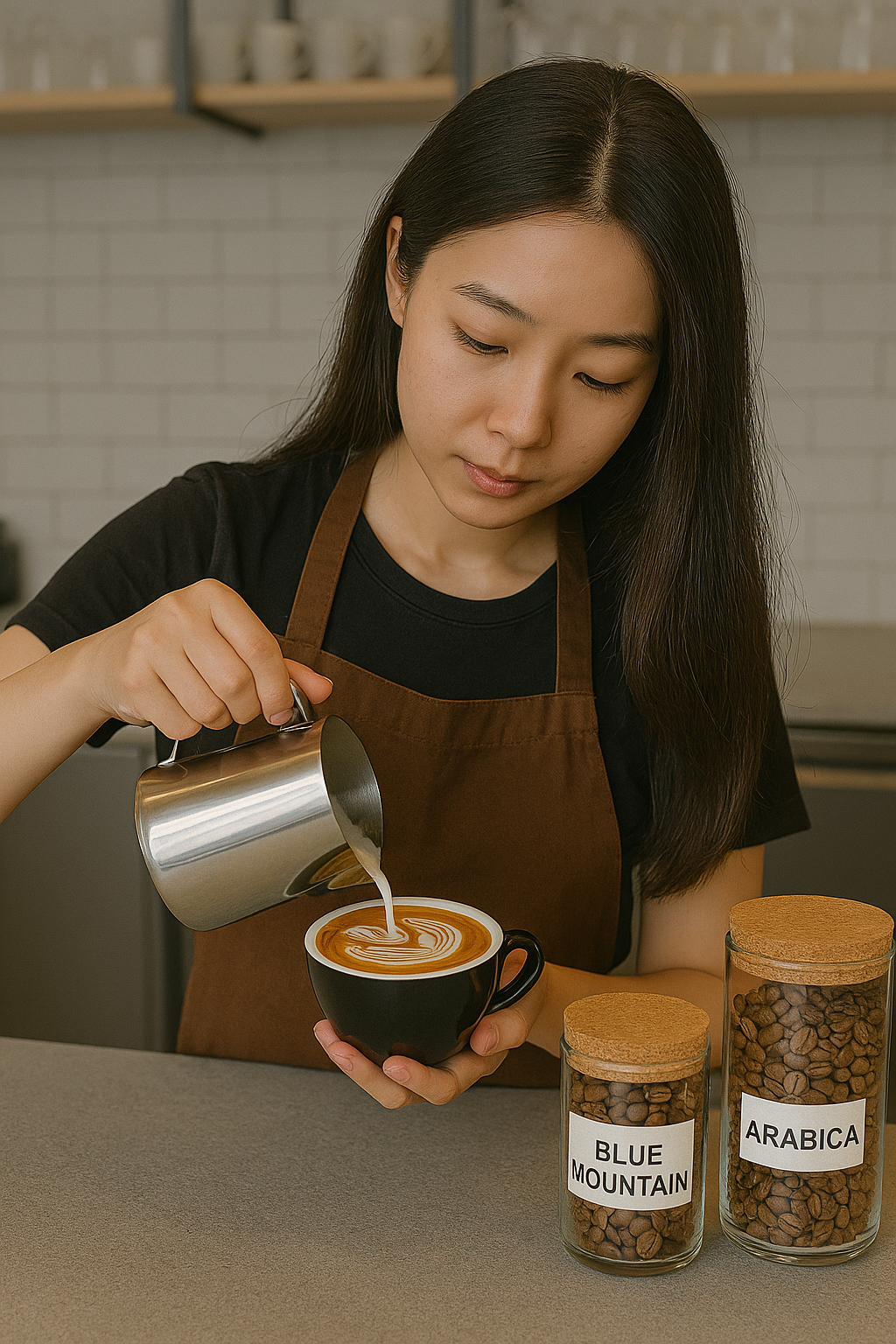The Coffee Lover’s Guide to SOE Single Origin Espresso Beans
The Coffee Lover’s Guide to SOE Single Origin Espresso Beans
Blog Article
Discovering the Abundant Tastes of Coffee Beans: a Deep Dive Into Coffee and Blended Coffee Beans
When you discover the rich flavors of coffee beans, you discover a complicated globe where each selection brings its own personality to your mug. As you browse with the art of espresso and the creativity behind blended coffees, you'll start to appreciate the subtleties that make each sip one-of-a-kind.
The Origins of Coffee Beans: Discovering Terroir and Flavor Profiles
When you take a sip of coffee, you're not simply appreciating a beverage; you're experiencing a rich tapestry of tastes shaped by the beans' beginnings. Each region generates special flavor accounts affected by soil, elevation, and climate. As an example, beans from Ethiopia frequently rupture with intense, fruity notes, while those from Colombia have a tendency to offer a well balanced, nutty sweetness.
As you explore various beginnings, you'll discover just how terroir-- the ecological factors impacting a plant-- plays an essential duty - Single Origin Espresso. The exact same coffee variety can taste dramatically different relying on where it's grown
When you think about these aspects, you begin to appreciate the complexity behind your cup. Each sip informs a tale of the land and the farmers that supported the beans. So, next time you indulge, think concerning the trip your coffee took before it reached your hands, and enjoy those complex tastes that mirror its origin.
Recognizing Coffee: The Art and Science Behind the Mixture
When you believe concerning coffee, it's not practically the solid taste; it's also about the strategies that bring it to life. Recognizing how various prep work techniques effect taste can transform your brewing experience. Allow's discover the intricacies of coffee preparation and discover the one-of-a-kind flavor profiles that make each cup unique.
Coffee Prep Work Strategies
Espresso preparation is both an art and a science, incorporating exact techniques with a deep understanding of coffee. To start, you'll desire to pick top quality, fresh baked beans and grind them finely for ideal removal (Single Origin Espresso). The grind dimension is vital; also rugged, and your espresso will certainly be weak, too great, and it'll be bitter
Next, tamp the premises uniformly in the portafilter to guarantee consistent extraction. When you lock it right into the machine, go for a brewing temperature between 190 ° F and 205 °
F.As you draw the shot, look for the excellent removal time-- around 25-30 seconds. The result needs to be a rich, luscious espresso with a gorgeous layer of crema ahead. With technique, you'll master these strategies.
Flavor Accounts Described
The globe of coffee supplies an abundant tapestry of taste accounts that can elevate your coffee experience. Light roasts commonly display intense level of acidity and vivid tastes, while dark roasts existing deeper, bolder tones.
Comprehending these accounts aids you select the ideal coffee for your taste buds. Trying out different blends can expose unexpected combinations. For circumstances, a well-crafted mix could integrate the intense notes of an Ethiopian bean with the abundant, chocolatey undertones of a Brazilian bean. Embrace the journey of discovering espresso's varied tastes, and you'll transform your coffee ritual right into an amazing adventure.
Processing Approaches: Just How They Influence Taste and Fragrance
While it may seem that the origin of coffee beans is one of the most considerable element in determining their taste and scent, the handling techniques used post-harvest play an equally essential duty. You'll discover that these approaches can dramatically modify the final preference profile of your mug.
As an example, the washed procedure removes the fruit from the beans prior to fermentation, commonly bring about a cleaner, brighter taste. The natural procedure leaves the fruit undamaged during drying out, resulting in a sweeter, fruitier profile.
Various other techniques, like honey handling, strike a balance, permitting some fruit mucilage to continue to be, offering an one-of-a-kind intricacy.
Each handling strategy engages with the beans' integral qualities, enhancing or silencing particular tastes and fragrances. When you sip that espresso or mixed coffee, bear in mind that the journey from cherry to cup is affected not simply by beginning however also by exactly how those beans were refined.
Toasting Strategies: Unlocking the Full Possible of Coffee Beans
Roasting methods are necessary for disclosing the complete possibility of coffee beans, as they change raw, environment-friendly beans right into the fragrant, delicious coffee you appreciate. The selection of toasting approach-- light, tool, or dark-- substantially affects taste accounts.
A slower roast at lower temperature levels permits for intricate flavors to create, while a quicker roast can increase bitterness. By understanding these methods, you'll disclose a world of taste, raising your coffee experience to new heights.
The Magic of Blended Coffee: Creating Distinct Flavor Experiences
Creating an unique taste experience with blended coffee can change your morning ritual into an exploration of preference. By incorporating different beans from numerous regions, you can disclose a harmony of flavors that boost your cup to brand-new elevations. Each blend deals a distinct account, stabilizing sweetness, body, and acidity to create something absolutely special.
When you pick a blend, you're not just selecting a coffee; you're selecting a trip across diverse landscapes and societies. Try out various mixes allows you to find your individual faves, whether you take pleasure in fruity notes or abundant, chocolatey undertones.

Sampling Notes: Recognizing the Nuances in Your Cup
As you drink your coffee, you could see a spectrum of flavors dancing on your taste buds, each exposing the intricacies of the beans. You may taste the brilliant acidity similar to citrus or the deep, abundant notes akin to dark chocolate. The sweetness might stimulate honey or sugar, stabilizing the general account perfectly.
Take note of the body of the coffee-- does it really feel light and ventilated, or is it complete and luscious? The coating, also, provides clues; a remaining aftertaste might mean nuttiness or flower touches.

Do not fail to remember to check out the distinct features of various origins, as each area gives unique tastes - Single Origin Espresso. Ethiopian coffees frequently existing fruity notes, while Colombian beans may display a much more rounded sweet taste. By recognizing these subtleties, you'll strengthen your admiration for each and every cup, raising your coffee experience to brand-new elevations

Developing Approaches: Maximizing Flavor Extraction for each Bean
When you explore the different developing approaches, you'll discover that each method can substantially impact the flavor profile of your coffee. From French press to pour-over, each method removes various compounds, improving or silencing particular notes. As an example, utilizing a French press enables oils to continue to be in the mixture, producing a richer preference, while pour-over stresses quality and brightness.
Temperature level and grind size likewise play essential roles. Single Origin Espresso A coarser grind works best for chilly mixtures, while a great work is perfect for coffee. Try out water temperature level-- in between 195 ° F and 205 ° F-- can reveal covert tastes, too.
Don't forget steeping time; a quick removal can lead to sour notes, while over-extraction may generate bitterness. By changing these variables, you can take full advantage of taste removal and truly raise your coffee experience. Appreciate the trip of uncovering what method ideal suits your taste!
Regularly Asked Inquiries
What Is the Ideal Water Temperature Level for Developing Coffee?
The excellent water temperature for developing coffee's between 195 ° F and 205 ° F. If you use water that's too hot, you'll over-extract flavors; also chilly, and you won't remove sufficient. Go for that pleasant spot for the best brew!
How Does Grind Size Affect Coffee Flavor?
Grind size considerably impacts coffee taste. Better grinds remove extra oils and tastes, causing a bolder preference, while coarser grinds return a lighter flavor. Changing grind size helps you achieve your desired coffee profile.
Are There Health Benefits Associated With Drinking Coffee?

What Is the Distinction Between Arabica and Robusta Beans?
Arabica beans are smoother and sweeter, frequently including fruity flavors, while robusta beans are stronger with a bitter preference and higher high levels of caffeine content. You'll see these distinctions in aroma and developing experience.
Just How Can I Shop Coffee Beans for Freshness?
To store coffee beans for quality, maintain them in a closed container, far from dampness, warmth, and light. If you only grind what you need right prior to brewing., you'll keep their taste longer.
Discovering the Rich Flavors of Coffee Beans: a Deep Dive Into Espresso and Blended Coffee Beans.
When you discover the abundant flavors of coffee beans, you uncover a complicated globe where each selection brings its own character to your cup.When you take a sip of coffee, you're not just enjoying a drink; you're experiencing a rich tapestry of flavors formed by the beans' beginnings.Roasting strategies are vital for revealing the complete potential of coffee beans, as they change raw, green beans into the aromatic, delicious coffee you enjoy.As you drink your coffee, you may observe a range of flavors dancing on your taste buds, each disclosing the details of the beans.
Report this page